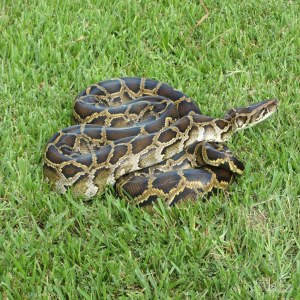 The Burmese python is one of the five largest species of snakes in the world. Burmese pythons are dark-colored snakes with many brown blotches bordered in black down the back. The female is slightly larger and heavier than the male. The Burmese python is considered an invasive species in the United States, specifically in southern Florida. Decreasing numbers of foxes, rabbits, raccoons, opossums, deer, birds and coyote have been noted in the following five years.
The Burmese python is one of the five largest species of snakes in the world. Burmese pythons are dark-colored snakes with many brown blotches bordered in black down the back. The female is slightly larger and heavier than the male. The Burmese python is considered an invasive species in the United States, specifically in southern Florida. Decreasing numbers of foxes, rabbits, raccoons, opossums, deer, birds and coyote have been noted in the following five years.
Location: Education Animals
Share:
Range
Burmese pythons are native to tropical South and Southeast Asia.
Habitat
Often found near water and sometimes semi-aquatic they can also be found in trees. Wild pythons average twelve feet long but have been known to reach eighteen feet. They are excellent swimmers and need a permanent source of water. They can be found in grasslands, marshes, swamps, rocky foothills, woodlands, river valleys, and jungles with open clearings.
Conservation Status
Vulnerable
Primary Threats
Human Wildlife Coexistence
Gestation
hatched often remain inside their eggs until they are ready to complete their first shedding of skin, after which they hunt for their first meal.
Litter
Clutch is between 12 – 36 eggs in March or April
Behavior
Burmese pythons are mainly nocturnal rainforest dwellers. They are good climbers and have prehensile tails. Younger pythons will go to the trees, but as they age and get larger they tend to stay on the forest floor. Being excellent swimmers, pythons can stay submerged for up to half an hour. They are known to be easygoing or timid creatures.
Reproduction
Breed in early spring and the eggs are only cared for until the young break through the shells.
Wild Diet
The Burmese pythons are carnivorous. They will consume any mammal presented to them as they are opportunistic feeders and will act hungry even if just fed.
Zoo Diet

